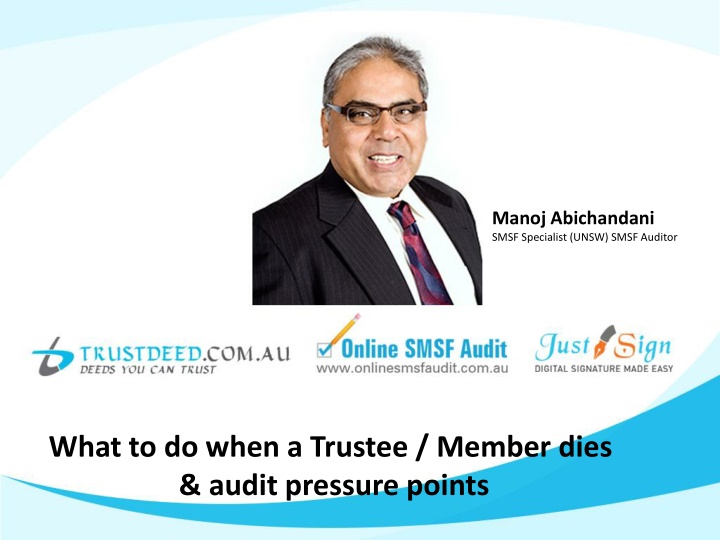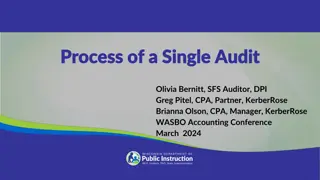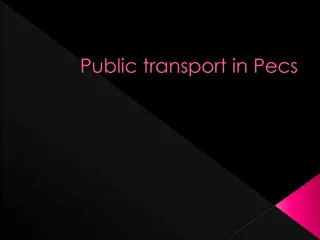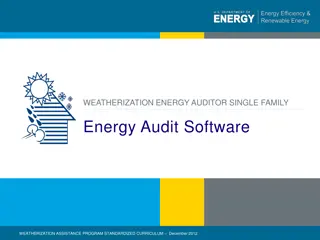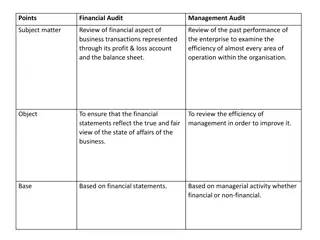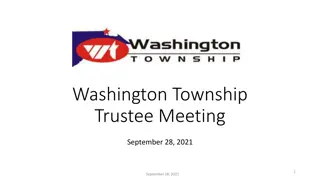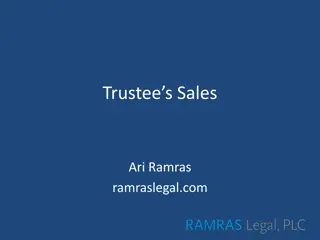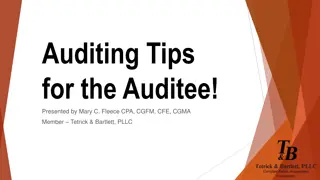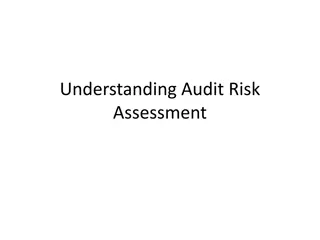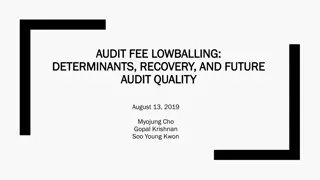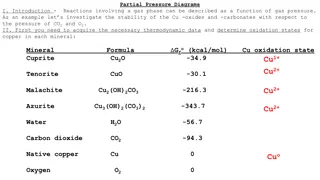Managing SMSF Audit Pressures and Procedures When a Trustee or Member Passes Away
Handling a Self-Managed Superannuation Fund (SMSF) audit when a trustee or member dies can be complex. Understand the steps to take when faced with this situation, including the requirements for members in the accumulation and pension phases, and the audit procedures for the year of death. Learn about the compulsory cashing requirements under legislation like SISR 6.21 and how to manage beneficiaries and legal representatives efficiently.
Download Presentation

Please find below an Image/Link to download the presentation.
The content on the website is provided AS IS for your information and personal use only. It may not be sold, licensed, or shared on other websites without obtaining consent from the author.If you encounter any issues during the download, it is possible that the publisher has removed the file from their server.
You are allowed to download the files provided on this website for personal or commercial use, subject to the condition that they are used lawfully. All files are the property of their respective owners.
The content on the website is provided AS IS for your information and personal use only. It may not be sold, licensed, or shared on other websites without obtaining consent from the author.
E N D
Presentation Transcript
Manoj Abichandani SMSF Specialist (UNSW) SMSF Auditor What to do when a Trustee / Member dies & audit pressure points
House Keeping - Audio If Computer sound is not audio able 1. Phone the number on your panel 2. Enter Access Code
House Keeping Hand Out Copy of this Presentation can be downloaded From the Panel
House Keeping Questions on this Presentation If you have any Questions on this Presentation 1. Type in your questions in the panel 2. Speaker will answer all your questions after the presentation
Disclaimer of Legal & Financial Advice - Educational Purpose Only Statement This paper represents the opinion of the author (s) and not necessarily those of Deed Dot Com Dot Au Pty Ltd. The contents are for general information only. They are not intended as professional advice - for that you should consult a Accountant or other suitably qualified professional. Deed Dot Com dot Au Pty Ltd expressly disclaims all liability for any loss or damage arising from reliance upon any information in this presentation. Disclaimer The information contained in this presentation is based on the understanding of the author has of the relevant Australian laws as at 12th May 2021. As these laws are subject to change you should refer to ATO s website or talk to a professional adviser for the most up-to-date information. The information is for adviser use only and is not a substitute for investors seeking advice. While all care has been taken in the preparation of this document (using sources believed to be reliable and accurate), no person, including Deed Dot Com Dot Au Pty Ltd, accepts responsibility for any loss suffered by any person arising from reliance on this information. This update is not financial product advice and does not take into account any individual s objectives, financial situation or needs. Any examples are for illustrative purposes only and actual risks and benefits will vary depending on each investor s individual circumstances. You should form your own opinion and take your own legal, taxation and financial advice on the application of the information to your business and your clients.
AGENDA What to do when a Trustee / Member Dies 1. List of things to done 2. Member in Accumulation 3. Member in Pension Phase 4. Audit of fund in the year of death
Legislation SISR 6.21 : If you have a superannuation interest when you die, your death creates a compulsory cashing requirement for the superannuation provider - to your beneficiaries or to your legal personal representative as soon as practicable. For dependant beneficiaries, superannuation death benefits can be cashed: SISR 6.21 (2) (a) as a superannuation lump sum that is paid out of the superannuation system, SISR 6,21 (2) (b) as death benefit income streams that are retained in the superannuation system (from 1 July 2017 such superannuation income streams must also be in the retirement phase), or a combination of the two. For non- dependant beneficiaries or your legal personal representative, superannuation death benefits can only be cashed as a superannuation lump sum that is paid out of the superannuation system
Who is a dependent SISR 6.21 (2A) Death benefit income stream, a dependant beneficiary is a dependant of the deceased member, which includes: a spouse a child under 18 years of age a financially dependent child who is under 25 a child who is disabled irrespective of their age, and a person who was in an interdependency relationship with the deceased (Sec 10A of SISA)
What does as soon as practicable mean Within a week Can it go on for 3 years or over
Situations when a one member of the fund dies More than one member in the fund Accumulation Phase With a BDBN Invalid BDBN With Non-BDBN Pension Phase With a reversionary pension With a non-reversionary pension Single Member Fund Accumulation Phase With a BDBN Invalid BDBN With Non-BDBN Pension Phase With a reversionary pension With a non-reversionary pension
More than one member in the fund - Accumulation Phase With a BDBN - Prepare a set of accounts credit income till date of death - No Trustee discretion on who gets the money - Assets sold or In-specie Death Benefit payment - Check the BDBN if death benefit can be paid as a Pension - Check the beneficiary s wishes With Non-BDBN or an invalid BDBN - Prepare a set of accounts credit income till date of death - Trustee discretion on who gets the money - Assets sold or In-specie Death Benefit payment - No need to check if the Non-BDBN if death benefit can be paid as a Pension Trustee has a discretion - Check the beneficiary s wishes
Reversionary Pension Vs Non- Reversionary Pension Conditions: 1 A reversionary death benefit income stream is a superannuation income stream that reverts to the reversionary beneficiary automatically upon the member s death Put in place - prior to the member s death . Reverts because the governing rules or the agreement under which the superannuation income stream is provided expressly provides for reversion Reverts not because the trustee exercising a power or discretion to determine a benefit in the beneficiary s favour or it is mentioned in the Binding Death Benefit Nomination (BDBN) Or 2. superannuation income stream ceases on the member s death.
How dependent get affected by Balance Transfer Cap - Section 294 -25(1) of ITAA Where the deceased member s interest is retained within the superannuation system and cashed to a dependant beneficiary in the form of a death benefit income stream, a credit arises in the dependant beneficiary s transfer balance account. A death benefit income stream can either be reversionary or non- reversionary Note: Once Total Superannuation Balance (Not Transfer Balance Cap) has reached $1.7 M (from 1st July 2021) No more non-concessional contributions allowed.
Multi member fund In Pension Phase
Reversionary Pension and Transfer Balance Cap The transfer balance credit that arises in your transfer balance account as a result of receiving a death benefit income stream may cause you to exceed your transfer balance cap So that you no longer exceed your transfer balance cap you can choose: 1) Commute fully or partially the death benefit income stream (cannot be retained as an accumulation phase interest and the commuted amount must be paid out of the superannuation system to you as a death benefit superannuation lump sum) or, 2) Commute fully or partially your own income stream (If you have one, in the retirement phase to remain within the superannuation system as an accumulation phase interest)
More than one member in the fund - Pension Phase - When one in a couple dies Steps to be Taken with Reversionary Pension Prepare a set of accounts Credit all members for income from 1st July to date of death Large amounts of family wealth in super will exit the super environment Reversion of Pension can be at anytime within 12 months Survivor s pension may need to be commuted to accumulation to accept reversionary pension Surviving member may end up with an accumulation account BDBN will be required Reversionary pensions of the survivor needs to be changed new beneficiary to be added and if there is no beneficiary then the survivors pension has to be a non-reversionary pension Transfer balance Account with ATO may need to be lodged
More than one member in the fund - Pension Phase - When one in a couple dies Steps to be Taken with Non- Reversionary Pension Prepare a set of accounts Credit all members for income from 1st July to date of death Large amounts of family wealth in super will exit the super environment Reversion of Pension must be automatic on Date of death Survivor s pension may need to be commuted to accumulation to accept reversionary pension Surviving member may end up with an accumulation account BDBN will be required Reversionary pensions of the survivor needs to be changed new beneficiary to be added and if there is no beneficiary then the survivors pension has to be a non-reversionary pension Transfer balance Account with ATO may need to be lodged
Single member fund in Pension Phase
Non- Reversionary Death Benefit Pensions A non-reversionary death benefit income stream is a new superannuation income stream created and paid to the dependant beneficiary or beneficiaries. Conditions: If the trustee has the power or discretion to determine: to whom the death benefit is paid the form in which the death benefit will be paid (for example as a superannuation lump sum or a superannuation income stream), or the amount of the death benefit paid.
Death benefit pensions Vs reversionary pensions Transfer balance credit arises in your transfer balance account (Section 294-25(1) of ITAA) in both cases as the death benefit pension is in retirement phase from 1st July 17 The time at which the credit arises for reversionary pension is: (a) for death benefit income streams commencing before 1 July 2017 the later of 1 July 2017 or 12 months from the day the death benefit income stream first became payable, and (b) for death benefit income streams commencing on or after 1 July 2017 12 months from the day (the starting day) when you started to be the retirement phase recipient of the death benefit income stream
Single member fund Member dies - Accumulation Phase With a BDBN - Prepare a set of accounts credit income till date of death - Check if there is another Trustee - or Appoint a Trustee with a court order - Lodge 484 form etc for appointment of Corporate Trustee - No Trustee discretion on who gets the member balance - Assets sold or In-specie Death Benefit payment for Lump Sum payment - Check the BDBN if death benefit can be paid as a Pension - Check the beneficiary s wishes With Non-BDBN or an invalid BDBN - Check if there is another Trustee - or Appoint a Trustee with a court order - Lodge 484 form etc for appointment of Corporate Trustee - Trustee discretion on who gets the money - Assets sold or In-specie Death Benefit payment for Lump Sum payment - No need to check if the Non-BDBN if death benefit can be paid as a Pension Trustee has a discretion - Check the beneficiary s wishes
Single member fund - Pension Phase with reversionary pension Steps to be Taken Prepare a set of accounts Credit all members for income from 1st July to date of death Check if the beneficiary is a dependent of the member Check if there is another Trustee of the fund Add the non-member as beneficiary as a Trustee / Member of the fund Beneficiary may want a lump sum and may want to exit the super environment Reversion of Pension can be at anytime within 12 months deceased member remains in pension phase Beneficiary may be on pension pension may need to be commuted to accumulation to accept reversionary pension Beneficiary may end up with an accumulation account BDBN will be required Beneficiary may want to revert the pension which has been reverted to Him / Her - New beneficiary to be added and if there is no beneficiary then the beneficiary pension has to be a non-reversionary pension by a BDBN Transfer balance Account with ATO may need to be lodged
Single member fund - Pension Phase with - Non Reversionary Pension Steps to be Taken Prepare a set of accounts Credit all members for income from 1st July to date of death Check if the beneficiary is a dependent of the member if Pension has to be paid or the pension can only be paid out as a Lump Sum Check if there is another Trustee of the fund - Trustee may need to be appointed by court Add the non-member as beneficiary as a Trustee / Member of the fund Beneficiary may want a lump sum and may want to exit the super environment Trustee Desc Reversion of Pension must be automatic and immidiately on date of death Reversion of Pension must be automatic on Date of death Survivor s pension may need to be commuted to accumulation to accept reversionary pension Transfer balance Account with ATO may need to be lodged
Joint Death - Adding more complexities More than one member in the fund or Single member funds - No other Trustees in the fund Members can be Accumulation or in Pension Phase or mixed SMSF could have a borrowing SMSF has property
Audit Issues Auditors duty to report to the Trustee if the funds position is going to go deteriorate
Key issues, actions and strategies for Auditors Withdrawal from Superannuation System Survivor of Couple capacity to understand issues Men die first Single member fund has only Adult Children 2nd Trustee to be appointed on death of first Pensions are they reversionary of not BDBN = are they in place ask the questions Passwords of bank accounts Statistics : In most cases : 2nd dies within 5 years of 1st Lumpy Assets in the fund High Taxable component Management report is an important tool which must be used
Announcements Justsign.com.au for Free Price Increase from 1st July 2021 100 150 Funds Single Plan Valued $770 200 300 Funds Small Plan Valued $880 300 + Funds Enterprise Plan Valued $990 1 or 5 10 - 25 50 300 500 2000 4,000 From $17 to $25 $4 $3 $2 No Change Commencing from 1st July 2021
For further Enquires please visit our websites: www.trustdeed.com.au www.onlinesmsfaudit.com.au www.justsign.com.au and chat with our agent. Alternatively, you - contact us 0296844199 or Email us at sales@trustdeed.com.au sales@onlinesmsfaudit.com.au sales@justsign.com.au
